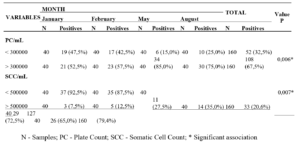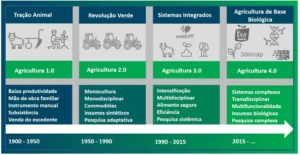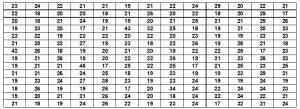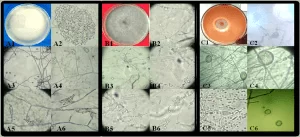ORIGINAL ARTICLE
SILVA, Jean Augusto Bueno da [1], JEZIORSKI, Cleiton Luís [2], KLARMANN, Paulo André [3]
SILVA, Jean Augusto Bueno da. JEZIORSKI, Cleiton Luís. KLARMANN, Paulo André. Effects of potassium fertilization management, with and without addition of calcium source, on grain yield and its components in soybean crop. Revista Científica Multidisciplinar Núcleo do Conhecimento. Year. 07, Ed. 02, Vol. 02, p. 35-53. February 2022. ISSN: 2448-0959, Access link: https://www.nucleodoconhecimento.com.br/agronomy-en/potassium-fertilization
ABSTRACT
The correct fertilization is one of the most important and essential factors for a good development, in terms of productivity, in the soybean crop. In this context, the research problem raised was: the yield components and the soybean grain yield are significantly affected by the management of potassium fertilization plus the annual addition of calcium in the edaphoclimatic conditions of Três de Maio – Rio Grande do Sul (RS), in the two harvests under study ? The present study aimed to evaluate the effect of different managements of potassium fertilization, with and without the addition of a source of calcium, on the yield of grains and their components in the soybean crop under the climate and soil conditions of the municipality of Três de Maio – RS, in crop years 2019/20 and 2020/21. For the collection of numerical data it was used the method of quantitative approach, the methods of procedures used were the methods of statistical and experimental procedure. Intensive direct observation by observation was used, for data collection and analysis, descriptive and inferential statistics were used. As for plant density, there was no significant difference between treatments. Regarding the vegetable density component, the average found was 992 vegetables/m2, not differing statistically between treatments. The number of grains per legume also showed no significant difference between treatments. As for the thousand-grain mass component, no significant differences were found between the treatments in the two years of cultivation. Regarding grain yield, in the 2019/20 harvest the average yield was 2465 kg ha-1 while in the 2020/21 harvest the average yield was 4214 kg ha-1, and in both harvests there were no significant differences yield between treatments. Based on the results obtained in the present study, it can be concluded that the components of yield and grain yield were not influenced by the management of potassium application and the addition of a source of calcium in the soybean crop, in oxisols with high levels. of fertility.
Keywords: Glycine max, Grain production, Fertilization management.
1. INTRODUCTION
Soybean (Glycine max) has great prominence in the world economy in the 2009/2010 harvest, the production was 259.7 million tons where about 102 million hectares were cultivated (USDA, 2011). In Brazil, the high productivity makes the country the second largest producer of this oilseed in the world, thus being one of the main commodities in the Brazilian agribusiness market (USDA, 2011).
This continuous improvement in soybean productivity is due to new technologies developed to increase yield per area, since the challenge is to produce more in the same areas, so it is important to know the best fertilization management to be adopted to achieve higher yields.
The big question arises at the time of pre-planting, where the form of application of nutrients is being defined, as there are two ways to do it, by casting or in the planting line. According to Tomé (2019) the application mode can change the speed and capacity of fertilizers in the soil, with differences when applied by broadcast or in the sowing line.
The knowledge of these managements is essential to increase production, as productivity depends on the form of fertilization and its application. Tomé (2019) establishes that fertilization in the row is when it is carried out together with planting and application by broadcast is carried out on the surface of the soil where it can be before or after planting.
Potassium is one of the fundamental elements for the development of the soybean crop, as it helps in the formation of the cell wall and in the transport of nutrients to the grain filling, thus generating greater productivity and stability for the crop (MALAVOLTA, 2006).
The nutrients Calcium and Magnesium have similar behaviors being absorbed as components of organic matter, and little absorbed when the pH is very high according to Raij (2011).
According to Melém Júnior et al. (2015) the soybean crop showed an increase in productivity with the increase of potassium fertilization, that is, without the addition of this nutrient, the productivity was 1943 kg ha-1 and with 90 kg ha-1 of K2O the productivity was 2,572 kg ha-1, as well as the number of vegetables per plant. Also according to Marcos Filho (2005), adequate nutrition directly influences the size and weight of crop grains.
Therefore, knowing the importance of nutrients for the development of the soybean crop, Reetz (2017) affirms the importance of fertilizers for the recovery of soil fertility and also for increasing crop productivity. Therefore, it is important that studies are carried out to compare the effectiveness of different managements of application of potassium fertilization with the use of calcium to increase production.
The correct management of soil fertility is an essential condition for the success of any crop, as well as for the soybean crop. Identifying the soil’s ability to supply nutrients to plants and planning appropriate fertilization management strategies are important decisions to achieve high yields. For this, it is essential to carry out a soil analysis.
In this context, the research problem raised was: the yield components and the soybean grain yield are significantly affected by the management of potassium fertilization plus the annual addition of calcium in the edaphoclimatic conditions of Três de Maio – RS, in the two harvests under study ? The present study aimed to evaluate the effect of different managements of potassium fertilization, with and without the addition of a source of calcium, on the yield of grains and their components in the soybean crop under the climate and soil conditions of the municipality of Três de Maio – RS, in crop years 2019/20 and 2020/21.
2. METHODOLOGICAL ASPECTS
Through the development of this research work, we sought to evaluate the effects of the management of potassium fertilization, with and without the addition of a source of calcium, on the yield of grains and their components in the soybean crop.
Therefore, the following problem was formulated: The yield components and soybean grain yield are significantly affected by the management of potassium fertilization plus the annual addition of calcium in the soil and climate conditions of the municipality of Três de Maio-RS, 2019/20 harvests and 2020/21?
The hypotheses formulated to help solve the problem were:
Potassium fertilization, when carried out on the surface, by broadcast, will promote significantly greater increments in grain yield, in relation to application in the sowing furrow, in both years of cultivation; Soybean yield components in the second crop are significantly affected by the nutritional treatments studied; When a source of calcium is added to the treatments performed, there is a significant increase in the mass of a thousand soybean grains in both crops, regardless of the management of potassium fertilization; The use of a source of calcium in the soil promotes lower extraction of potassium by soybean plants at 30, 60, 90 days and by grains, in the condition of the second crop, regardless of its form of application; The use of a calcium source for two consecutive years significantly affects soybean grain yield in the second crop, due to the residual effect of this element in the soil.
Quantitative approach methods were used to collect and analyze data regarding yield components (plant density, legume density, number of grains per legume and thousand-grain mass), grain yield and nutrient concentration in the phytomass. of culture.
The procedural methods used were statistical and experimental. The statistical procedure was used for the numerical analysis of the data (plant density, legume density, number of grains per legume, thousand grain weight, nutrient concentrations in the phytomass of the crop and grain yield). the experimental procedure was used in the design and conduction of the test in the field, having a treatment as a control
Data collection was through intensive direct observation by observation, used to collect numerical data referring to grain yield, as well as yield components. Descriptive and inferential statistics were used for data analysis, through analysis of variance (ANOVA) and the values were compared using Tukey’s test at 5% error probability.
The population under study is the set of soybean plants of the cultivar M 6410 IPRO, which has an indeterminate growth habit of maturation group 6.4, comprising the various plots that made up the field experiment.
To evaluate the grain yield and thousand grain weight, the grains that were harvested in the useful area of the plots were used, which was composed of four meters of the 3 central lines. For the evaluation of the yield components and determination of the nutrients present in the phytomass, the plants of the destructive area, composed of 1.5 meters from each end of the plots, were used.
The study on screen had an experiment implemented in the field in Vila Manchinha, municipality of Três de Maio, at coordinates 27°42’13” S and 54°13’53” at an altitude of 308 meters in relation to sea level and the Soil is classified as Typical Red Latosol Dystroferric Typic (EMBRAPA, 2013), the experiment was implemented under a no-till system, with wheat being the antecedent crop.
The experimental design was in completely randomized blocks distributed in 6 treatments and 4 replications, totaling 24 plots measuring 2.5 meters wide by 7 meters long.
Regarding the amount of fertilizers used, in the 2019/20 crop, in the first crop condition, treatments T1 and T2 received 234 kg ha-1 of the formulated fertilizer NPK (02.23.23), applied in the sowing line, treatments T3 and T4 received 118 kg ha-1 of SF + 25 kg ha-1 of KCl, applied in the sowing line, and treatments T5 and T6 received 118 kg ha-1 of SFT in the sowing line + 25 kg ha-1 of KCl, applied to the surface.
In the 2020/21 crop, in second crop condition, treatments T1 and T2 received 390 kg ha-1 of the formulated fertilizer NPK (02.23.23), applied in the sowing line, treatments T3 and T4 received 120 kg ha-1 of SFT + 150 kg ha-1 of KCl, applied in the sowing line, and treatments T5 and T6 received 120 kg ha-1 of SFT in the sowing line + 150 kg ha-1 of KCl applied in the surface.
The calcium-based fertilizer Fort Cal (38% Ca + 0.5% Mg) was applied only in treatments T2, T4 and T6, on the surface, at a fixed rate of 200 kg ha-1.
The plots were composed of 5 lines, spaced 50 cm between lines and seven meters in length, making up an area of 17.5 m², which was divided into useful area and destructive area. In the useful area, four meters of the 3 central lines were harvested to measure the grain yield. Samples were taken from these harvested grains to determine the weight of a thousand grains and the concentration of Ca, Mg and K in the grains.
3. THEORETICAL REFERENCE
The first soybean plants, more than 5 thousand years ago, had the characteristics of a creeping plant, and after natural crosses between two wild soybean species, they were domesticated and improved by scientists from ancient China (DALL’AGNOL et al., 2007). , giving rise to a soybean very similar to the one that is currently cultivated.
According to data from CONAB (2020), grain production in Brazil for the 2019/20 harvest reached 120.3 million tons, a record in the historical series, representing an increase of 4.6% compared to last year. In Rio Grande do Sul, production was approximately 25,970 thousand tons, placing the state among the 5 largest soybean producers in the country.
Soil fertility is the soil’s ability to provide essential elements to plants and, according to Lopes and Guilherme (2007, p. 1) it is one of the most important components for the development of agriculture, especially with regard to increasing agricultural productivity. However, to achieve high productivity, plants need more nutrients than those supplied by the soil, thus requiring the use of inputs containing nutrients to maintain fertile soils.
Fertilization management interferes with the efficiency of fertilizers and the adoption of different application methods must consider the operational, agronomic and economic aspects (FIORIN, VOGEL; BORTOLOTTO, 2016). Therefore, the mode of application can change the speed and ability of fertilizers to react in the soil, being therefore different when the fertilizer is applied by broadcast or together with sowing (TOMÉ, 2019).
Tomé (2019) defines in-line fertilization as the application of fertilizers and seeds at the same time in the sowing line, while broadcast fertilization as the application of fertilizers superficially in the soil, usually occurring before sowing.
In many cases, according to Fiorin, Vogel and Bortolotto (2016, p. 95) “…the broadcast applications may not provide the amounts of nutrients necessary for the initial development of the plants, while applications in the line, in high doses , can result in damage to the root system”.
Potassium is the second most absorbed nutrient by cultivated plants and the maintenance of adequate levels of this nutrient in agricultural soils requires special attention (BENITES et al., 2010; PRADO, 2008).
In the case of calcium and magnesium, both occur in the soil in the cationic forms (Ca2+) and Mg2+). Calcium is adsorbed in soil colloids (Exchangeable Ca) or as a component of organic matter, and may precipitate as poorly soluble carbonates, phosphates or sulfates when the pH is high (RAIJ, 2011; PRADO, 2008; TROEH; THOMPSON, 2007). Due to the low concentration of calcium in acidic soils, it is recommended to use correctives such as limestone (calcium carbonates) which, in addition to neutralizing acidity, act as an important source of calcium.
The assimilation of potassium by plants occurs in the ionic form (K+), occurring through several systems (transporters and in channels) (PRADO, 2008) and depends mainly on the diffusion of the element through the soil solution, which can also happen by mass flow. (RAIJ, 2011). Among the factors that can affect the absorption of potassium by plants are moisture, concentration of the nutrient in the soil and the age of the plant, where younger roots present greater absorption compared to old roots (PRADO, 2008). After absorption, potassium is rapidly transported via the xylem to the shoot (MALAVOLTA, 2006).
In the case of calcium, the ways in which it can be absorbed by plants is as Ca2+ ion and chelated calcium (MALAVOLTA, 2006). Its absorption does not occur only by mass flow, but also through root interception (PRADO, 2008) and its transport after reaching the xylem occurs passively and acropetalously, that is, it is unidirectional (MALAVOLTA, 2006).
In the case of interactions between K, Ca and Mg, an increase in the dose of K causes a decrease in the contents of Ca and Mg, as well as the interaction between Ca and Mg in the soil solution is antagonistic, that is, the excess of one impairs the absorption of the other (PRADO, 2008; MOORE, OVERSTREET; JACOBSON, 1961).
4. PRESENTATION AND DISCUSSION OF RESULTS
Regarding the concentration of nutrients in the phytomass of the crop, laboratory analysis was performed to determine the concentration of K, Ca and Mg at 30, 60 and 90 days after emergence (D.A.E) in order to identify the absorption of these nutrients by plants at different stages. of culture development, as shown in figure 1.
Figure 1 – Concentration of K, Ca and Mg in the phytomass of the crop at 30, 60 and 90 D.A.E
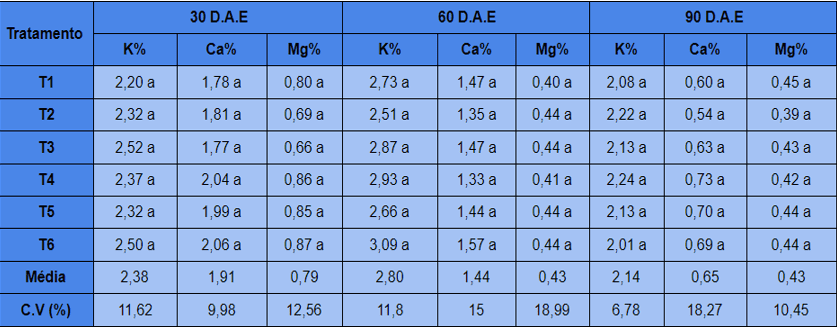
At 30 D.A.E, there was greater absorption of Ca, Mg and K by the plants in the treatments in which calcium-based fertilizer was applied, but there was no statistical difference in relation to the other treatments, this increase in nutrient absorption may be related to the high rainfall in December and January, with monthly rainfall above 220 millimeters, thus facilitating the dissolution of fertilizers and making nutrients available in the soil solution.
At 60 D.A.E, a small increase in the concentration of Ca, Mg and K was observed in treatment 6 (SFT + KCl (haul) + Calcium), but this difference was also not significant compared to the other treatments.
The values found at 90 D.A.E show higher concentrations of Ca and K in treatment 4 (SFT+KCl (line) + Calcium), but the highest concentrations of Mg were found in treatment 1 (N-P-K 02.23.23), but as in previous seasons did not present significant differences in relation to the other treatments.
Figure 2 shows the levels of potassium, calcium and magnesium present in soybean grains in the 2019/20 and 2020/21 harvests.
Figure 2 – K, Ca and Mg contents in soybean grains in the 2019/20 and 2020/21 harvests
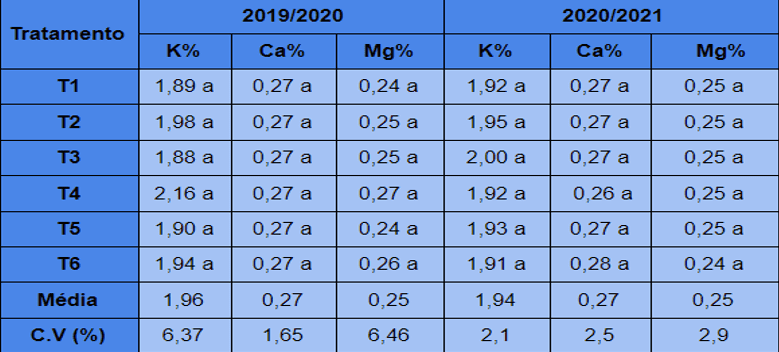
Regarding the analysis of the concentration of nutrients present in the grains of the soybean crop, we can observe that in the 2019/20 crop there was a small increase in the concentration of Potassium and Magnesium in the treatments where the application of calcium was carried out, but these values did not differ statistically in relation to treatments in which this fertilizer was not applied.
Regarding Calcium, it did not show any difference in relation to its concentration in soybean grains in the 2019/20 harvest.
In the 2020/21 crop, higher concentrations of potassium were found in treatment 4, where fertilization with SFT + KCl (row) was performed, but this difference was not significant in relation to the concentration of potassium in the grains of the other treatments.
Regarding calcium, it is observed that in the 2020/21 crop the highest concentration was found in treatment 6, where fertilization was performed with SFT + KCl (haul) + Calcium, but it also did not show a significant difference in relation to the other treatments.
The same occurred in relation to the concentration of Magnesium in the grains, where no differences were found in relation to the different forms of application of potassium in the fertilization of the crop and the addition or not of calcium-based fertilizer.
Figure 3 presents the data regarding the density of legumes (Densidade Legumes) of each of the treatments under study, in the 2020/21 harvest.
Figure 3 – Density of vegetables in the 2020/21 harvest.
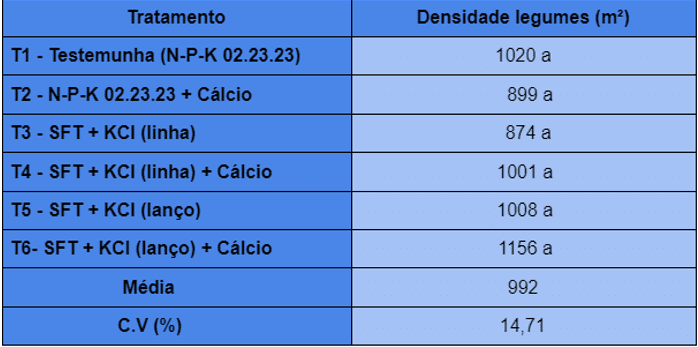
Regarding the density of vegetables, it was found that there was no significant difference between treatments, and the average found was 992 vegetables m², where the highest density (1155 vegetables m²) was observed where SFT+KCl (haul) was used + Calcium (T6), whereas the lowest density (874 vegetables m²) was found in T3 (SFT+KCl (row).
As for the form of potassium application, Mantovani et al. (2017), in a study carried out, state that the method of potassium application had no significant influence on the number of vegetables per plant, both in the application of potassium throughout the sowing line and all potassium applied on the surface, as well as there was no statistical difference in compared to the control, without potassium application, in soil with high levels of this nutrient.
As for the number of grains per vegetable in the 2020/21 harvest, the results obtained can be seen in figure 4.
Figure 4 – Number of grains per vegetable in the 2020/21 harvest.
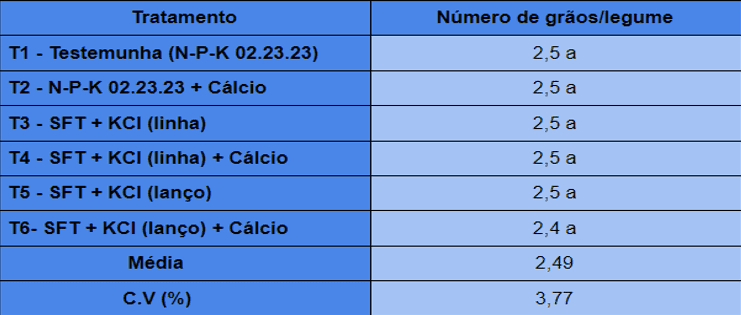
As shown in Figure 4, it can be observed that an average of 2.49 grains per legume was obtained, with no significant difference between the treatments under study, this result can be explained as a result of the nutrient levels found in the soil being high for phosphorus is too high for potassium.
In a study carried out by Peter et al (2016), they claim not to have found significant differences in the number of grains per vegetable regarding the different forms of fertilizer application, corroborating the study in question.
According to the data presented in Figure 06, in relation to the mass of a thousand grains (MMG), the average obtained in the treatments under study was 128.71 g in the 2018/20 harvest and 130.2 in the 2020/21 harvest.
Figure 5 – Mass of a thousand grains in the 2019/20 and 2020/21 harvests.
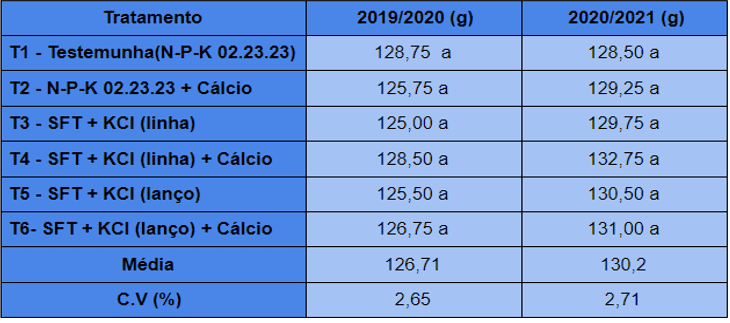
When we mention the performance component (MMG), we can observe in figure 06 that in the two years of study, in which this component was analyzed, no significant differences were found in its values when submitted to the Tukey test analysis at 5% of probability.
Regarding MMG, it is observed that both in the 2019/20 harvest and in the 2020/2021 harvest, the average values of MMG were below those presented by the company that owns the cultivar used, which would be 145 gr.
It can be seen in figure 5 that in the 2019/20 crop the highest value (128.75 gr) was found in the control treatment (T1), where only fertilizer 02.23.23 was applied, but there was no statistical difference in relation to the values of the other treatments.
In Crop 2020/21, the highest values (132.75 g) were found in treatment 4, where SFT + KCl (line) + calcium was applied, but there was no statistical difference when compared to the other treatments, as well as in relation to the control.
According to Vogel (2016) in an experiment in the municipality of Cerro Largo with different forms of potassium and phosphate application by casting and on the line, there was also no significant relationship in their treatments with regard to the mass of a thousand grains.
For Navarro Junior and Costa (2002) the average grain mass is a characteristic that is strongly related to genetics, being a characteristic of each cultivar, being modifiable by the environmental conditions.
In relation to grain yield, the results obtained in the two years of cultivation can be seen in figure 6.
Figure 6 – Grain yield in the 2019/20 and 2020/21 harvests
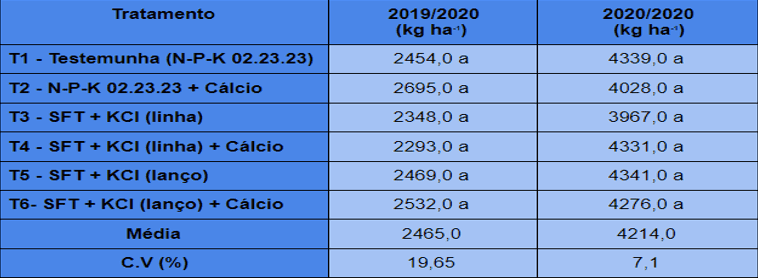
Regarding the grain yield of the 2019/2020 harvest, it is observed that the highest yield occurred in the treatment in which NPK 02.23.23 + calcium was used, with 2695 kg ha-1, but there was no statistical difference in relation to the other treatments .
It can also be observed that the average yield of treatments in the 2019/2020 crop was lower than the yield expectation, established at 3600 kg ha-1, being affected by the low volume of rainfall during the crop cycle.
Malavolta (1980) states that periods of water deficit in the vegetative development phase reduce plant growth, decrease leaf area and grain yield.
When citing the grain yield in the 2020/2021 crop, it is observed that the highest yield occurred in treatment 5, where SFT + KCl (haul) was applied, with a productivity of 4341 kg ha-1, while the lowest yield occurred in the treatment 3, in which SFT + KCl (row) was applied, with a yield of 3967 Kg ha-1, but these values did not differ statistically from the other treatments.
The results obtained are similar to those found by Bernardi et al. (2009), where they claim to have found no significant difference in grain yield in relation to the form of potassium application in soybean in red clayey soil with potassium level classified as high.
Pettigrew (2008) states that responses to potassium fertilization can be obtained under different managements, as long as the soil has low availability of the nutrient.
5. CONCLUSION
Through the present study, it was possible to evaluate the influence of the effects of potassium fertilization management, with or without the addition of calcium, on the yield components and grain yields of soybean in red latosol in the 2019/20 and 2020/ crop years 21.
With the scope of the objectives proposed in this study, it is possible to analyze the hypotheses formulated according to the following.
The first hypothesis that “potassium fertilization, when performed on the surface, by broadcasting, will promote significantly greater increments in grain yield, in relation to application in the sowing furrow, in both years of cultivation” is not confirmed, due to the lack of there is a statistical difference between the yields of the other treatments under study, which can be explained by the fact that the potassium levels originally found in the soil are classified as very high by the Soil Chemistry and Fertility Commission RS/SC, 2016, being sufficient to supply the nutritional requirements of the crop.
Regarding the hypothesis that “soybean yield components in the second crop are significantly affected by the nutritional treatments studied” was also not confirmed for any of the analyzed yield components, since, by performing the Tukey test at 5% of significance in the results obtained in the 2020/2021 crop, it was possible to verify that there was no significant effect on the yield components among the treatments under study, as well as there was no statistical difference of these same yield components in the first year of cultivation.
On the other hand, the hypothesis that “when a source of calcium is added to the treatments performed, there is a significant increase in the mass of a thousand soybean grains in both crops, regardless of the management of potassium fertilization” was also not confirmed, since there were no differences between the two. significant for these treatments.
The hypothesis that “the use of a source of calcium in the soil promotes lower extraction of potassium by soybean plants at 30, 60, 90 days and by grains, in the condition of the second crop, regardless of its form of application” was not confirmed. , since there were no significant differences in relation to potassium concentration in the phytomass of the crop at 30, 60 and 90 A.A.E, as well as in the harvested grains.
Regarding the last hypothesis, that “the use of a calcium source for two consecutive years significantly affects soybean grain yield in the second crop, due to the residual effect of this element in the soil” was also not confirmed, since in none of the treatments that received calcium application were significant differences in grain yield in the 2020/2021 crop compared to treatments that did not receive calcium application.
In response to the research problem, it can be said that there were no significant differences on yield components and grain yield by the different managements of potassium fertilization plus annual addition of calcium in the soil and climate conditions of Três de Maio, RS, 2019/2019 harvests. 2020 and 2020/2021, showing no significant differences from the control.
After the conclusion of the study on screen, it can be said that potassium, when applied to the surface, does not lead to increases in soybean productivity in soils classified as Typical Dystroferric Red Latosol with high fertility rates, however, the present work opens up opportunities of carrying out other studies with the objective of evaluating the influence of the forms of potassium application in the soybean crop.
REFERENCES
BENITES, Vinicius de Melo; CARVALHO, Maria da Conceição; RESENDE, Álvaro Vilela; POLIDORO, José Carlos; BERNARDI, Alberto Carlos De Campos; OLIVEIRA, Fabio Alvares de. O potássio, o cálcio e o magnésio na agricultura brasileira. In: PROCHNOW, Luís Ignácio; CASARIN, Valter; STIPP, Silvia Regina. Boas práticas para uso eficiente de fertilizante. Piracicaba: IPNI. 2010. pp. 133-204.
BERNARDI, Alberto Carlos de Campos; OLIVEIRA JÚNIOR, Juarez Patrício de; LEANDRO, Wilson Mozena; MESQUITA, Tiago Gomes da Silva; FREITAS, Pedro Luiz de; CARVALHO, Maria da Conceição Santana. Doses e formas de aplicação da adubação potássica na rotação soja, milheto e algodão em sistema de plantio direto. Pesquisa Agropecuária Tropical. V. 39. n. 2. Goiânia: Universidade Federal de Goiânia. Abr./Jun. 2009. pp. 158-167.
CONAB. Acompanhamento da safra brasileira de grãos, safra 2019/2020. Brasília: Companhia Nacional de Abastecimento. 2020.
DALL’AGNOL, Amélio; ROESSING, Antonio Carlos; LAZZAROTTO, Joelsio José; HIRAKURI, Marcelo Hiroshi; OLIVEIRA, Arnold B. de. O complexo agroindustrial da soja brasileira. Circular Técnica 43. Londrina: EMBRAPA. 2007. ISSN 1516-7860.
EMBRAPA. Sistema brasileiro de classificação de solos. 3 ed. Brasília, DF. Embrapa informação tecnológica. 2013. ISBN 978-85-7035-198-2.
FIORIN, Jackson Ernani; VOGEL, Pedro Toigo; BORTOLOTTO, Rafael Pivotto. Métodos de aplicação e fontes de fertilizantes para a cultura da soja. Revista Brasileira de Ciências Agrárias. V. 11. n. 2. Recife: Universidade Federal Rural de Pernambuco. Jun. 2016. pp. 92-97.
LOPES, Alfredo Scheid; GUILHERME, Luiz Roberto Guimarães. Fertilidade do solo e produtividade agrícola. In: NOVAIS, Roberto Ferreira de; ALVAREZ, Victor Hugo V; BARROS, Nairam Félix De; FONTES, Renildes Lúcio; CANTARUTTI, Reinaldo Bertola; NEVES, Júlio César Lima. Fertilidade do Solo. Viçosa: SBCS. 2007.
MALAVOLTA, Eurípedes. Manual de nutrição mineral de plantas. 1 ed. São Paulo: Editora Ceres. 2006. ISBN: 8531800471
____ . Nutrição mineral e adubação da soja. Piracicaba: Escola Superior de Agricultura Luiz de Queiroz. 1980.
MANTOVANI, Analu; RIBEIRO, Fernando José; VEIGA, Milton; ZILIO, Marcio; FELICIO, Tamara Pereira. Método de aplicação de potássio na soja em nitossolo vermelho. Unoesc & Ciência. V. 8. n. 2. Joaçaba: Universidade do Oeste de Santa Catarina. Jul./dez. 2017. pp. 169 – 176.
MARCOS-FILHO, J. Fisiologia de sementes de plantas cultivadas. Piracicaba: FEALQ, 2005.
MELÉM JÚNIOR, Nagib Jorge; FABER, Jean; GALLO, Juliano; OLIVEIRA JUNIOR, Raimundo Cosme de; SILVA, Alessandra Damasceno da; OLIVEIRA, Daniel Rocha de. Avaliação da produtividade da soja em diferentes doses de potássio na região de Belterra/PA. Congresso Brasileiro de Ciência do Solo, 35. Natal. 2015.
MOORE, David. P; OVERSTREET, Roy; JACOBSON, Louis. Aplicação de magnésio e sua interação em raízes de cevada. Plant physiology. V. 36. n. 3. Mai. 1961. pp. 290 – 295.
NAVARRO JÚNIOR, Hugo. Motta; COSTA, José Antonio. Contribuição relativa dos componentes do rendimento para produção de grãos de soja. Revista Pesquisa Agropecuária Brasileira. V. 37. n. 3. Brasília. Jan. 2002. pp. 269 – 274.
PETER, Dieter Gustavo; VILAR, Cesar Crispim; USHIWATA, Silvio Yoshiharu; RODRIGUES, Orismário Lúcio. Modos de aplicação de fertilizantes formulado NPK na cultura da soja em sistema de plantio direto. Global Science Technology. V. 9. n.1. Rio Verde: Universidade do Estado de Mato Grosso. Jan./abr. 2016. pp. 48 – 55.
PETTIGREW, William. Influências do potássio no rendimento e qualidade da produção de milho, trigo, soja e algodão. Physiologia Plantarum. V. 133. n. 4. Compenhagen. Jul. 2008. pp. 670 – 680.
PRADO, Renato De Mello. Nutrição de Plantas. São Paulo: UNESP. 2008. ISBN: 9788571396760.
RAIJ, Bernardo Van. Fertilidade do solo e manejo de nutrientes. Piracicaba: IPNI. 2011. ISBN: 9788598519074.
REETZ, Harold. Fertilizantes e seu uso eficiente. São Paulo: Associação Nacional para Difusão de Adubos. 2017. ISBN: 9791092366044.
TOMÉ, Paulo Capistrano Dias. Adubação a lanço versus na linha. 2019. [Online]. [Acessado em 07/11/2020] Disponível em: <www.pioneersementes.com.br/blog//adubacao-a-lanco-versus-na-linha>.
TROEH, Frederick; THOMPSON, Louise. Fertilidade do Solo. Tradução de DOURADO NETO, Durval; DOURADO, Manuella Nóbrega. São Paulo: Andrei. 2007. pp. 718
USDA. Produção, Fornecimento e Distribuição. United States Department of Agriculture. 2011.
VOGEL, Luander Silmar Bourscheidt. Avaliação da produtividade de soja em função da forma de aplicação de cloreto de potássio e super fosfato triplo. Trabalho de conclusão de curso em agronomia. Universidade Federal da Fronteira Sul, Curso de Agronomia. 2016.
[1] Bachelor in Agronomy. ORCID: 0000-0002-6849-2174.
[2] Bachelor in Agronomy. ORCID: 0000-0002-2493-0208.
[3] Advisor.
Sent: November, 2021.
Approved: February, 2022.

